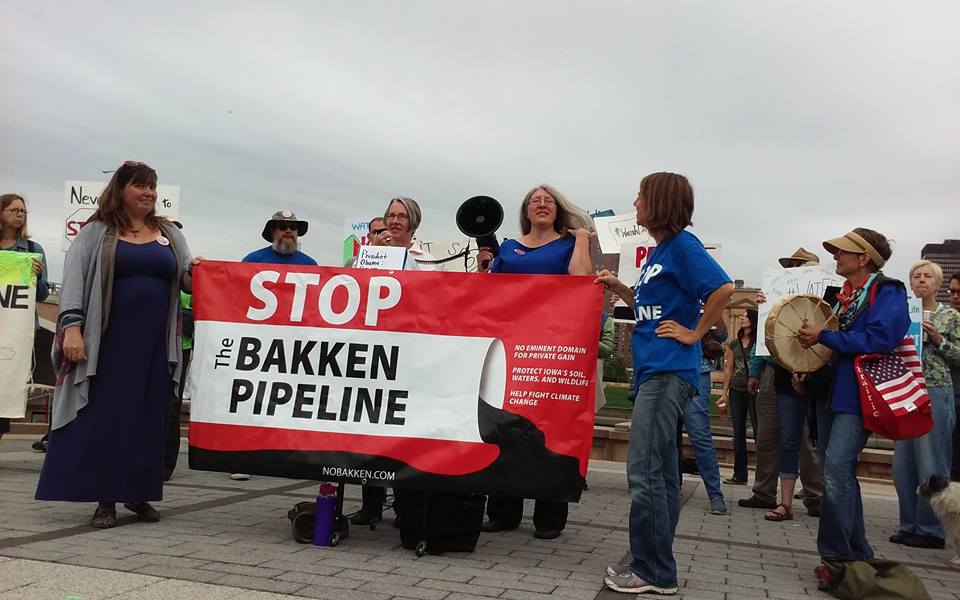The Rise of the Water Protectors
The Rise of the Water Protectors Networker Volume 21(5), Fall 2016
Networker Volume 21(5), Fall 2016
A letter from Carolyn Raffensperger, Returned from Standing Rock
Friends,
I write this in the heat of the struggle to block Dakota Access’ nefarious pipeline. I just returned from Standing Rock and jumped into protests for the Iowa reach of the pipeline. For over two years we at the Science & Environmental Health Network have been immersed in all forms of resisting the Dakota Access Pipeline (DAPL) — political, legal, media, and yes, direct action.
In August I joined many of my friends and colleagues at Standing Rock where I served as an on-the-ground lawyer. For a while I was the only lawyer at the camp and was involved in everything from issuing the call for international observers to interpreting legal decisions and their consequences.
Injunctions, temporary restraining orders and hydrostatic testing permits are not the usual topics of ordinary mortals’ conversations. What did it mean that the judge issued a temporary restraining order? Would Dakota Access be allowed to continue construction after it bull-dozed sacred sites? Why couldn’t the Army Corps of Engineers stop construction on private land?
My visit to Standing Rock was an outcome of the long-term work we’ve been involved in on Dakota Access and other pipelines in the Midwest. Our role both within the Iowa Bakken Pipeline Resistance Coalition and the larger regional coalition was to identify places to use existing law as well as to reform it to protect water and future generations.

If there is one lesson I take away from this, it is that the law of pipelines is fatally flawed. It is fundamentally flawed because it is broken up into a thousand pieces of decision-making, so nobody has responsibility for the whole pipeline. The environment is barely given a nod in the process and tribes are ignored unless they do something as unexpected as have thousands upon thousands of people show up at Standing Rock.
We have used every legal tool before us and invented some new ones along the way. We analyzed Dakota Access’ parent (one of many) company’s corporate annual reports, intervened in legal proceedings like the Iowa Utilities Board, translated the law so that activists, tribes and others could make decisions. We helped design a regional strategy with the Tribes, other NGOs, activists and government officials to block the pipeline.
In all of this we’ve had a number of firsts, including:
- analyzing the annual reports of DAPL’s parent companies and this caused the Iowa Utilities Board to require Dakota Access to have irrevocable parental guarantees to pay for a spill. We believe that is a first in the history of crude oil pipelines. Iowans won’t be left holding the bag if there is a spill. intervening in a pipeline proceeding on behalf of future generations. I was on-the-ground at Standing Rock helping to interpret the legal decisions as they were handed down and guide strategy at the camps.
- creating the first ever pipeline construction monitoring guide for county boards and activists, which has resulted in citizen watchdogs calling in violations of DAPL’s permit conditions.
- identifying places to intervene in the policy and legal systems that were not on the radar until we brought them to the attention of activists. For instance, as I write this, there are two permits that have not yet been given to DAPL, one is the 408 permit at Standing Rock. The other is a hydrostatic testing permit. No one in the nation has ever challenged a hydrostatic testing permit. We believe it can be done.
Dakota Access is just one of many pipelines that are being proposed in this country. We desperately need reformation of the entire process including strategies to keep fossil fuels in the ground.
This is the work ahead of us: both to find the paths through the existing legal thickets that lead to stopping polluting, unjust pipelines and to create new paths that help us fulfill our moral obligations to future generations.
We are not done yet. We have had many losses in this struggle against Dakota Access and a few wins. But there is no oil flowing through that pipeline yet. Join us in making sure it never does.
— Carolyn Raffensperger
An Almanac of Interesting and Little Known Facts about DAPL Resistance
--The Iowa Coalition is named the Bakken Pipeline Resistance Coalition (BPRC) because Dakota Access hadn’t even been incorporated when we started our work. The BPRC is engaged in the same struggle as the activists at Standing Rock: it is a long pipeline.
--The Standing Rock Sioux Reservation is not the only Sioux location that is affected by the pipeline. The territory that is governed by Sioux treaty rights is vast and includes western Iowa. In June, a sacred site was discovered in NW Iowa near the Big Sioux River and the tribes were able to temporarily block construction. Unfortunately, pipeline will be bored deep under the site.
--There is almost no mechanism for accountability once a pipeline is granted its permits and construction begins. Construction happens in an enforcement vacuum. There is supposedly some oversight by an underfunded, understaffed, weak agency called Pipeline and Hazardous Materials Safety Administration (PHMSA), but it doesn’t monitor the day to day construction. The future failures of the pipeline are built into the rushed construction and nobody with authority is watching.
--The Army Corps of Engineers has emerged as a central environmental decision-making agency. Environmentalists are used to dealing with USEPA, BLM and Department of the Interior, but not very familiar with the permitting processes of the Corps. As extreme energy extraction and transportation becomes the norm, the Corps will be in the center of the permitting processes.
--Over six federal agencies, three Iowa agencies, three South Dakota agencies, three North Dakota agencies and three Illinois agencies, not to mention all the county boards and drainage districts had to approve this pipeline. This has to change. All the agencies minimized their roles and responsibilities.
I repeat: this can’t go on.
Protectors of the Waters in pictures: the last two weeks resisting the DAPL


Want more photos: Check out this flickr highlights reel of solidarity actions across the country

